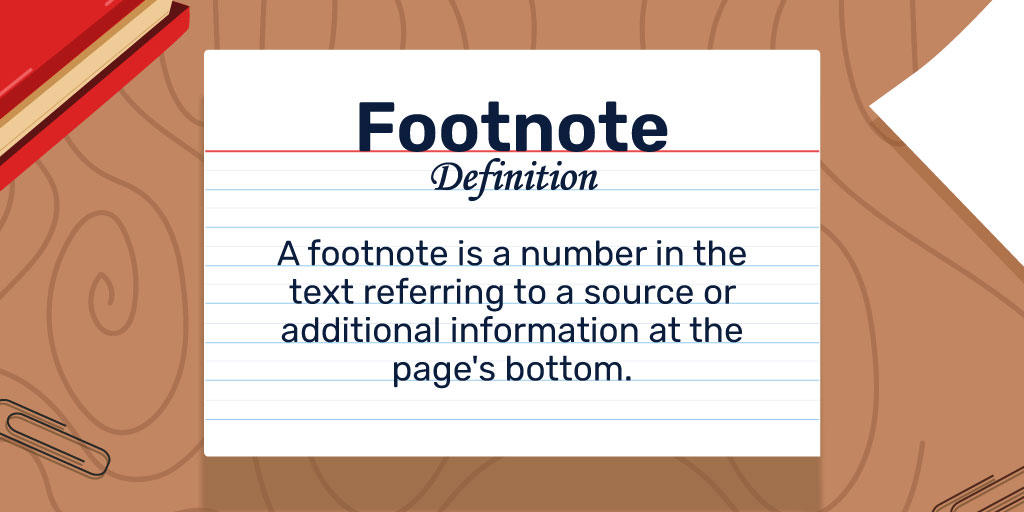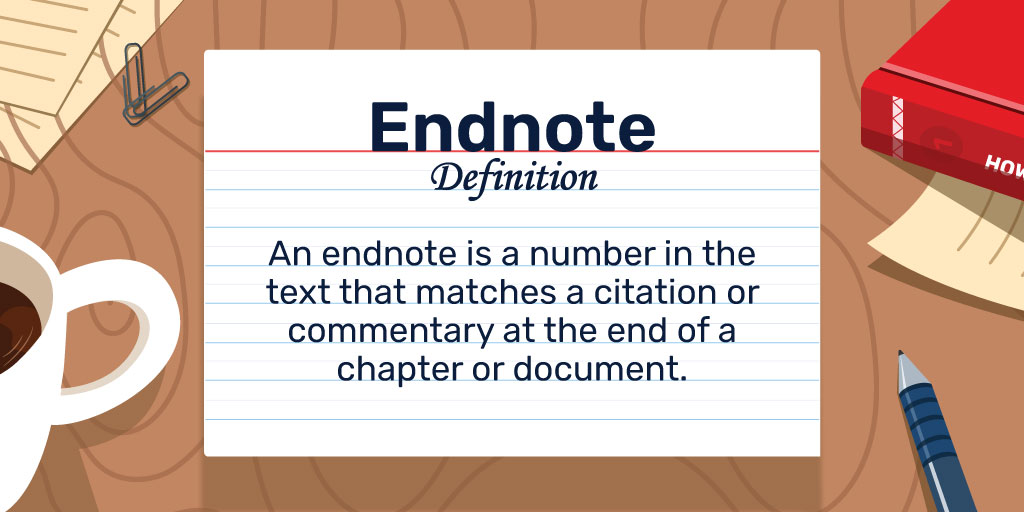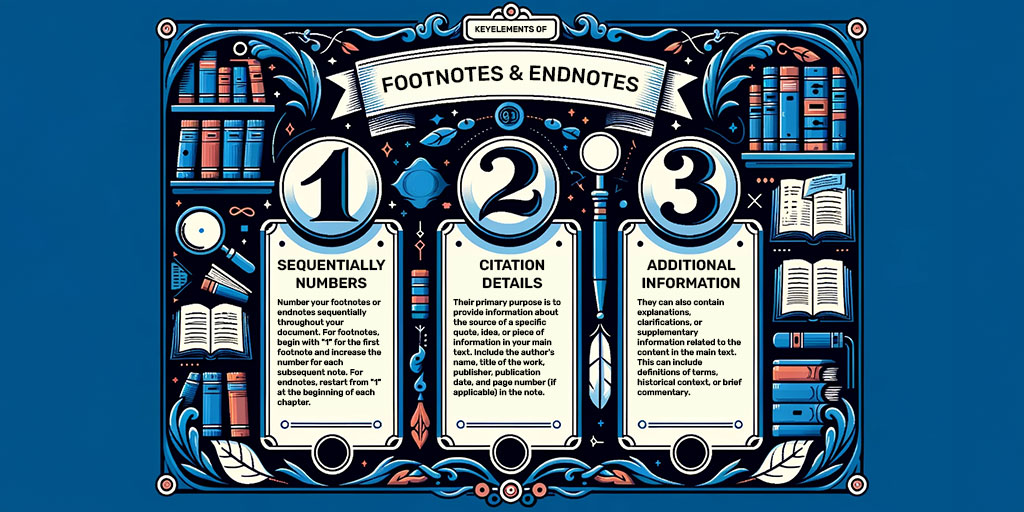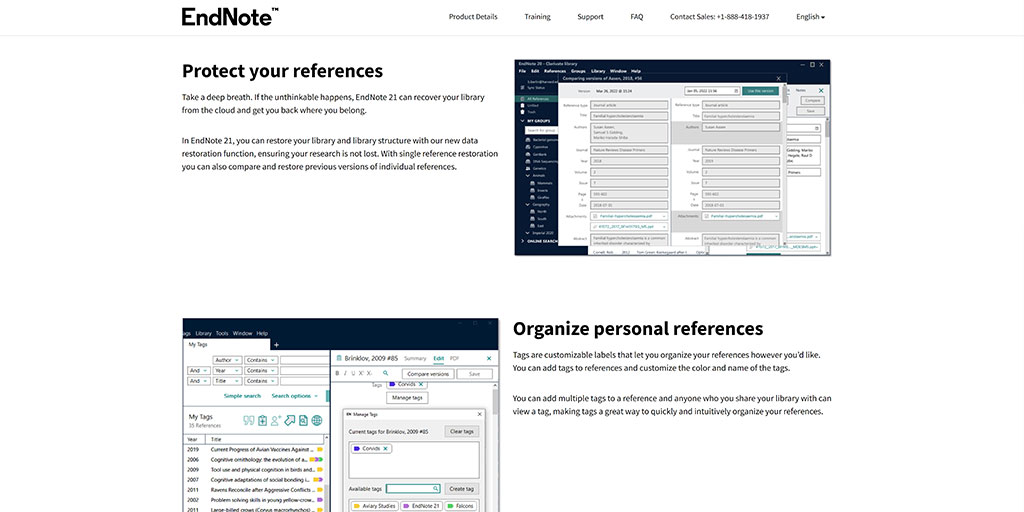Academia and professional disciplines place a premium on clarity and accuracy. Footnotes and endnotes are two tools that writers can use to raise the quality of their work. These subtle but important additions help establish the work’s scientific legitimacy by providing necessary background information, references, and clarifications.
However, knowing when to use footnotes and when to use endnotes, as well as the details of how to write them, may be challenging for writers. In this guide, we’ll examine the similarities and distinctions between the two, along with some examples to help illustrate how to write them.
What Is a Footnote?

A footnote is a reference placed at the bottom of a page within a document, typically in a smaller font size compared to the main text. Footnotes serve various purposes, but their primary function is to provide additional information, clarifications, citations, or comments related to specific content in the main body of the text.
Footnotes are usually numbered sequentially within a document, starting at the beginning and increasing with each subsequent footnote. They are placed at the bottom of the same page where the reference occurs, making it convenient for readers to access the relevant information without flipping to the end of the document.
Craft of Writing Quiz (Easy)

What Is an Endnote?

An endnote is a reference or explanatory note that is placed at the end of a chapter or an entire document, rather than at the bottom of individual pages as in the case of footnotes. They are normally grouped together in a dedicated section titled “Notes” or “Endnotes.”
Like footnotes, they can contain citations, explanations, commentary, or additional information that relates to the content of the document.
Endnotes are also numbered sequentially, but their numbering starts anew for each chapter. For example, if you have three endnotes in Chapter 1, they would be numbered 1, 2, and 3. In Chapter 2, the endnotes would start with number 1 again.
Footnote vs. Endnote: When to Use Which?

More often than not, the choice between footnotes and endnotes depends on the style guidelines you need to follow for your specific project. Academic journals, document publishers, and college professors often have particular requirements for what your document should look like, meaning that the choice isn’t yours. Following such guidelines is crucial if you want your work to be accepted.

But if you are lucky and you have a choice, your decision should be based on enhancing the reader’s experience, as explained below.
When to Use Footnotes
The biggest advantage of footnotes is that they provide immediate access to additional information or citations without requiring readers to flip to the end of a chapter or document. Their main downside is that they can clutter the bottom of the pages and become visually overwhelming.
Accordingly, use footnotes in work that involves:
- Immediate References: Choose footnotes when it’s essential for readers to have immediate access to additional information or explanations without interrupting their reading flow.
- Short Notes: Unlike long notes that take up dozens of lines, short notes can easily fit at the bottom of pages without cluttering up the text.
- Short Documents: Footnotes work well in shorter documents, such as essays, articles, or reports, where the number of citations and references is limited.
- Sequential Numbering: If your document benefits from sequential numbering, as when comparing notes across different chapters, footnotes are a more suitable choice, as endnotes may restart numbering at the top of every chapter.
When to Use Endnotes
The chief benefit of endnotes is their cleaner and less visually distracting main text, with all the notes hidden away at the bottom of the document. This is also their main disadvantage, however, since readers must navigate to the end of a section or document to access the notes, which can disrupt the reading flow.
As a result, use endnotes in work that involves:
- Clean Presentation: Opt for endnotes when you want to maintain a clean and uncluttered appearance of your document.
- Long Notes: To prevent long explanations and comments from taking up too much space on the same pages as the main text, it is useful to put them in a list at the bottom of the chapter or document.
- Many Citations/Long Document: The more citations there are, the neater it is to arrange them in one list at the end. It also keeps numbers manageable by restarting them at the beginning of chapters.
- Simplicity: Because all endnotes fit into one section, they are easier for the writer to compile, edit, keep track of, and format.
How to Write Footnotes and Endnotes

Now that you’ve decided which one to use, the next step is to learn how to write them. Since both include the same information and are formatted similarly, they are easy to learn. Let’s have a look.
What to Include in Footnotes and Endnotes
There are three things that can appear in your notes:
- Numbers: Number your footnotes or endnotes sequentially throughout your document. For footnotes, begin with “1” for the first footnote and increase the number for each subsequent note. For endnotes, restart from “1” at the beginning of each chapter.
- Citation Details: Their primary purpose is to provide information about the source of a specific quote, idea, or piece of information in your main text. Include the author’s name, title of the work, publisher, publication date, and page number (if applicable) in the note.
- Additional Information: They can also contain explanations, clarifications, or supplementary information related to the content in the main text. This can include definitions of terms, historical context, or brief commentary.
How to Format Footnotes and Endnotes

You can make this easy for yourself by following a recognized referencing style, which you can either look up online or get an app to do for you. Of the most common referencing styles, only the Chicago style uses endnotes and footnotes. MLA, APA, Harvard, and Vancouver, on the other hand, enclose the author’s surname in brackets inside the text together with either the date or the page number, followed by a reference list at the end of the document. For example, (Smith, 2020, 45) or (Smith 45).
Accordingly, if you need to include footnotes or endnotes and your publisher has not specified a referencing style, the Chicago style is the best one to choose.
For Chicago style, these are the basic guidelines:
- Placement: Place the footnote at the bottom of the same page where the reference occurs in your main text, or the endnote at the end of the chapter or document. For endnotes, create a dedicated section titled “Notes” or “Endnotes” to house them.
- Font: Use a smaller font size for footnotes to distinguish them from the main text. As endnotes are already separate from the text, they don’t require a different font.
- Numbering: Use superscript numbers (raised above the line of text) to indicate the footnote or endnote reference in the main text. The corresponding number should also appear at the beginning of the footnote or endnote.
- Line Spacing: The official Chicago style book still recommends that footnotes and endnotes are double-spaced. However, it has become an unofficial convention to use single-line spacing for both types of notes. Each new note should begin on a new line.
- Indentation: Footnotes and endnotes should use first-line indents, with subsequent lines being all the way on the left.
- Punctuation: Punctuate your footnotes and endnotes according to standard grammar rules. For example, end a note with a period (.) if it’s a complete sentence.
- Compiling the Text: For both types of notes, you write the Author first name last name, Title of Book (Place of publication: publisher, year), page number. If you are referencing a journal article, you write first name last name, “Title of Article,” Name of Journal volume, no. issue (year): page number.
- Bibliography: When using footnotes and endnotes, you should include an alphabetical list of references in a complete bibliography at the end of the document. In this list, the last name precedes the first name.
Footnote and Endnote Examples
To illustrate the procedures above, look at the following examples, first as notes, and then as an alphabetical bibliography. Remember that footnotes go at the bottom of the same page as the in-text number, while endnotes go at the bottom of the chapter or document. You can also write footnotes in a smaller font. Otherwise, both look like this.
Notes Format:
- William Gerber and Emily Mercer, Curiosity: A Recipe for Happiness (New York: Simon & Schuster, 2018), 16.
- Henry Mitchel, “Echoes of Eternity,” New Yorker, May 21, 2019, 22.
- Andrew Lucas, “Beyond the Veil of Time,” New England Review 42, no. 3 (2010): 95, 100.
- Sophia A. Bennett et al., “The Paradox Principle,” American Naturalist 195, no. 4 (April 2020): 465,
- Researchers should consult the specific style guide you’re using (e.g., Bluebook Legal Citation, Turabian, or Chicago) for any variations or additional requirements for formatting notes.
Bibliography Format:
- Bennett, Sophia A., Isabella Foster, Samuel Wallace, Louis Caldwell, and Ethan Chambers. “The Paradox Principle.” American Naturalist 195, no. 4 (April 2020): 463–73.
- Gerber, William, and Emily Mercer. Curiosity: A Recipe for Happiness. New York: Simon & Schuster, 2018.
- Lucas, Andrew. “Beyond the Veil of Time.” New England Review 42, no. 3 (2010): 95–109.
- Mitchel, Henry. “Echoes of Eternity.” New Yorker, May 21, 2019.
3 Tools to Create Footnotes and Endnotes
Since it is much too hard to remember to include every bit of information and punctuation in the right place, researchers and writers tend to use software to do it for them. These are called citation or reference managers. To give you an idea of the features they tend to include, have a look at some of the most popular ones.
1. EndNote

Running on both macOS and Windows, Endnote is one of the oldest and best reference managers out there. It keeps a database of all your citations both on the app and on the web to prevent data loss, but the web-based app is much more basic than its desktop cousin. You can sort references into folders or according to tags and import them directly from Google scholar and a variety of other scholarly databases.
It can insert your references directly into your Microsoft Word, Apple Pages, and Google Docs documents and ensure that the formatting of footnotes, endnotes, and bibliography is correct.
Because it is the most feature-rich of the apps, it is relatively pricy, but it does offer a variety of discounts for students, groups, and previous license holders.
2. Mendeley

A newer kid on the block, Mendeley‘s Windows, macOS, and web apps are fully functional, which means that you can even use it on your smartphone. It keeps your entire library in searchable form and inserts your references and notes into MS Word documents. You are also able to download and store full text articles and take notes in your own notebooks.
Mendeley is free for casual researchers, but charges monthly or annual fees for serious scholars that store more than two gigs of data.
3. Zotero

Zotero is open source and completely free, unless you want to buy a lot of additional storage space for notes and articles. It runs on the web, macOS, and Windows, and even tries to detect the citation details of pages as you browse the web.
Through plugins, it can insert your footnotes,endnotes, and bibliographies into MS Word, LibreOffice, and Google Docs and format them correctly according to more than 10,000 referencing styles.
Frequently Asked Questions

If you have any further questions about the use of footnotes and endnotes, they are likely to be answered in the section below.
What is the Difference between Footnote and Endnote?
The primary difference between a footnote and an endnote lies in their placement within a document.
Footnotes are placed at the bottom of the same page where the reference occurs in the main text. They are on the same page as the content they relate to.
Endnotes are placed at the end of a chapter or the entire document, depending on the author’s preference or style guidelines. They are often grouped together in a dedicated section titled “Notes” or “Endnotes.”
What is the Point of Using Footnotes and Endnotes?
The purpose of footnotes and endnotes is to allow authors to add further details, references, and explanations without breaking the flow of the main text. They keep the core material uncomplicated while still enabling readers to acquire more information and verify sources, boosting the writer’s clarity and credibility.
Can Footnotes and Endnotes Be Used in the Same Document?
The publishers of scientific journals almost never allow writers to use both footnotes and endnotes in the same document, but they do occasionally appear together in books. Writers can do this to distinguish explanatory notes from citation notes. In these cases, normal numbers are used to indicate endnotes, while an asterisk preceded by dagger signs are used for footnotes.
Can Footnotes Be Placed in the Middle of a Sentence?
Yes. A footnote or endnote number can be placed in the middle of a sentence if the sentence makes more than one statement to which the note can apply. However, it should always follow a punctuation sign to avoid breaking up the text.
Can Footnotes and Endnotes Be Used in Fiction?
Yes. Footnotes and endnotes can be used in fiction, but their use is less common and largely depends on the author’s stylistic choice. Some authors may incorporate footnotes or endnotes for humorous asides, as Sophie Kinsella does in her book “I’ve Got Your Number,” or for detailed worldbuilding, as J. R. R. Tolkien does in “Lord of the Rings”. But it’s essential to use them sparingly to avoid distracting the reader from the story.
Final Thoughts
Ultimately, whether you opt for footnotes or endnotes, the key is to use them thoughtfully and consistently. Remember that the primary goal is to enhance the clarity, credibility, and organization of your writing while ensuring a seamless reading experience for your audience.
Footnotes offer immediacy and accessibility, making them ideal for shorter works or situations where quick reference to sources is essential. On the other hand, endnotes provide a cleaner presentation in lengthy documents with numerous references, allowing readers to engage with the text more smoothly.
So, choose wisely, embrace their strengths, and let footnotes or endnotes be your allies in crafting more compelling and informative prose.
Craft of Writing Quiz (Hard)








